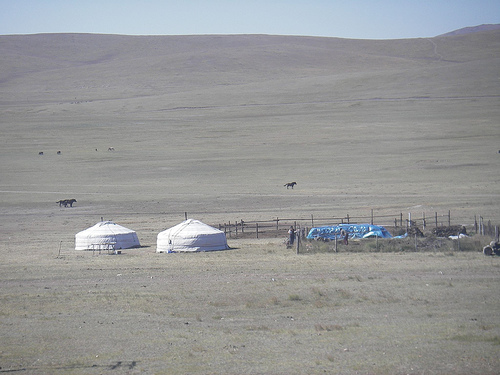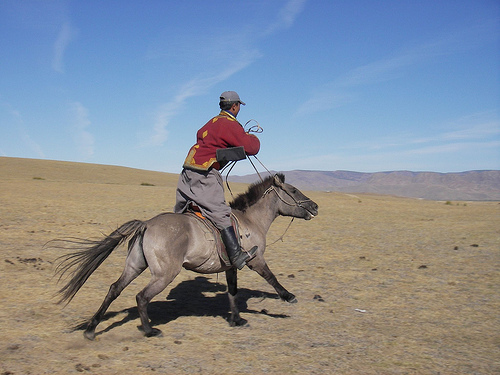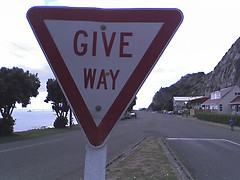language
Trans-Siberian: Beijing to Ulan Bataar
Leaving

Our first impression of our train compartment was one of amusement. Two couches facing one another, a small table, a window and lots of metal clips, hinges, handles, ladders and switches that did not appear at the time to have any utility. What made us laugh was the decoration – I would call it Russian Grandmother style. Darkish floral print that was perhaps dark with age and usage with gold satin frill. The curtains matched the beds and the diagonal tablecloth really tied the room together nicely. Ugly but certainly sufficient for the 1.5 day journey.

It wasn’t long before we realized that we were on the way out of
After the first 12 hours, we went to the dining car and returned to walk through a train filled with a dusty fog. It had a sweet smell, not like fire, but a bit like freshly cut wood. You could feel the air on your eyes and it your nose and it settled near the floor. The air was crunchy. At dusk we looked out of the window across the hall through a dust covered window. Through the dust spattered glass, we could see sand - the very beginnings of the
Border crossings are a bitch. Since the toilet flushes directly onto the tracks, the toilets on the train are locked during the border crossing into
In some strange turn of railroad evolution it came to be that railroads were connected that didn't match in width. Such is the case with the Trans-Siberian train which must be refitted with new wheels or "bogeys" before heading into
We awoke with the anticipation of a school kid on a snow day - what would we find when we opened the curtain for the first time? It turned out to be a scene of absolute nothingness - more nothing than we had ever seen anywhere. We looked out over an ocean of pure sand - the middle of the

Soon after waking we rattled into a small stop at the edge of the desert called Choyr, where eager Mongolian kids greeted us selling stones of quartz and amethyst. I expected to be mobbed when I stepped of the train, but they were polite and not tenacious on a level that I expected. I suppose
The run into Ulan Baatar was grassy rolling steppe - no vegetation over a foot high and gers that dotted the horizon along with their sheep, horses and cows. Disturbing the landscape on the train side were barbed-wire fences and electrical poles which are well used by White Tailed Eagles - certainly the most entertaining wildlife in view. The scrubby steppe is surely home to bite sized rodents that teased the eagles from their perches. It was not at all odd to see an eagle swoop down and attack just outside the window. It's nice to know this desolate place is feeding something so effectively.

Signs of Ulan Baatar slowly start to appeared from the window in the form of Gers that seem to be moving closer and closer together. A ger is a traditional Mongolian nomadic home – basically a round tent made of white felt or canvas. Most have no electricity or running water. Outside of the city you noticed gers as a white dot on the horizon, surrounded by livestock. It seemed that in the outskirts of Ulan Baatar, the nomads are inching their way towards stationary city life by planting their gers in more permanent positions around the city. In fact we would see them in downtown too.

The most immediate and striking aspect of Ulan Baatar was the women, many of whom were quite beautiful and dressed in the most up-to-date western fashions. I didn’t expect this in Ulan Baatar. The city itself is not beautiful and I described it at the time as appearing to be part refugee camp, part abandoned construction site and part modern city. It had all the conveniences that anyone would need – Internet cafes, supermarkets, movie theaters, restaurants, etc. The city has a reputation for lawlessness and aggressive pickpockets, but we saw no evidence of them.
Within an hour or so we boarded a mini-van and departed the city for Elstei Ger Camp, about 50 kms outside the city. Within about 30 minutes we reached the steppe – the land of absolutely endless rolling hills of grass. This is where we would spend the next two days.

Here are a couple of my favorite photos from our stay here...



This video is about our stay at the camp…
Vietnamese and the Real English
Like nearly traveler, we struggle with language – and sometimes even English. Case in point: Before coming to
Upon consulting the phrasebook, we found a very different version of the word about which we felt so confident. The book said it should be pronounced “fur”, which to us sounded like the hair on an animal. “Fur” did not sound Vietnamese at all. The same was true with the word for thank you – the book said it is pronounced "ga’am ern". Again, that “r” sound did not sound right.
Then the light went on in our head. The phrasebook’s pronunciation was based on British English – the real English and not our American version. “Fur” was not fur at all, but a much more sophisticated sounding “fuh”, where the “r” is dropped. I could suddenly imagine a British person holding a cup of tea with their pinky finger held out and saying “I would nevah weah a fuh coat- that’s simply cruel!” …and it all became very clear.
And in the end, we must recognize that we hold our version of English very dear and we Americans have to realize that our English is not the only, or even the real version of the language. There is a reason it is called “English”.
In Japan: My Name is...
I always have to spell my last name when making reservations anywhere. Even the French automatically spell it the traditionally correct way - LeFevre. I have to correct them to type in the American spelling - LeFever.
In Japan, the difficulty of this task has come to a new level and we have seen more interesting spellings than anywhere else. Moving from South Japan to North, here are versions 2 through 5:
LEHEBA
RESIBA
LEFIBE
LEFEBERU
Now, with my experience with the language, I completely understand the issue of "L"s and "R"s being used interchangeably, as their sound for them is right between the two. However, how do you explain this kicker we just received today as we arrived back in Tokyo?
MS. RESEGZ
I'm baffled. They must be too.
Not Fitting In Japan (Kanazawa)
Lee is 6'3" (190cm) tall and doesn't always seem to physically fit in Japan. Bus seats never have enough legroom. So many clothing shop clerks look at him and cross their arms in an "X" as if to say "Our clothes are too small for you!" Tonight the hotel attendant ran to find Lee larger house slippers because none would fit him.

He even tries his best to take up as little space as he can on the trains to avoid being the big American with big arm movements - we've noticed even the tiniest of school girls only open their small books half a page wide to read on the trains.

We visited a 350 year old temple/house in Kanazawa that was secretly built with 3 stories on the outside, but 7 "layers" on the inside. It is affectionately named "Ninja-dera" (Ninja Temple) because of the self-locking trap doors, see-through stairways and 27 hidden staircases.
Lee has been proud of not accidently punching an elbow through any fragile shoji doors, and being careful to watch low doorway beams over the last few weeks. However, that day he took a step back.
We were not allowed to take any photos, but the 350 year old beams provided many obstacles in small rooms as we followed the 8 person tour group through the floors. There was one room set under a stairway made of wooden slats and white paper so any intruders would easily be seen and subsequently find their legs slashed from under the stairs. The ceiling was maybe as high as his shoulder, but everyone else fit just fine standing in the room. He stood on the last step just outside of the ceiling beam peering into the room over everyone - a giant among the Japanese - grinning and waiting for end of the description in Japanese. Our calm and professional tour guide smiled along with the knowing chuckles of the Japanese in the group and kept her tour moving.
The next set of stairs leading to a room with 5 exits and secret stairways caught Lee by surprise. THUD! He whacked his forehead on the beam and grimaced "I almost made it all the way through the house!". Our tour guide couldn't help but giggle.
It's obvious that Japan's chairs, ceilings, clothes, vehicles etc. were not made for Lee but he's enjoying it all anyway, if only from afar or at least just outside peering in...
Literally Lost in Translation
Sachi had a very well-traveled instructor in grad school that told her that he feels confident in getting around in any country in the world- except
I feel so illiterate when looking at a menu. I know nothing- not one word, number or letter. I just have to depend on Sachi to do her best to read and talk to the server about what they have. I just look around at plates, point and make little utterances like “hai”, which means “yes”.

Our situation here differs from what we’ve experienced so far in the trip. Except for
For now, I just smile and say my konnichi wa’s and onegaishimasu’s and look to Sachi when they come back to me with a litany of words that seem completely incomprehensible. I know that when the sentence ends in “desuka”, it is a question and I am supposed to answer. Usually though, I have to look back at them and Sachi blankly, sending the not-too-secret message to Sachi that I’m helpless. Thankfully, she can usually get us (me) through with flying colors and I can answer with something like "America" or "hai". Good and gracious translator, that Sachi.
A Posty for Our Bloggy
Like in New Zealand, I've been fascinated with the tiny differences in language. There are all the British English words, but what I found truly Australian was the addition of a "y" or "ies" to the end of a word.
Here are a few I noticed:
People who drive trucks are truckies
People who sail yachts are yachties
Tasmania is tassie
Breakfast is brekky
Getting sick is feeling sicky
Sunglasses are sunnies
Cigarettes are ciggies
Names are often altered like Pammy Jilly
A drink is a drinky
A stuffed animal is a stuffy
and of course... Australians are Aussies.
Small Differences in Language
One of the things that makes New Zealand like home is the familiar language. Still, there a lots of tiny differences in NZ English that serve to amuse more than confuse us yanks. Most are from British English and some may be regional or innacurate. Here are some of the terms we've noticed...
A game room is a "games room"
You don't watch sports, you watch "sport".
Food or drink you take with you is "take away"
French fries are "chips"
In the car, you don't yield, you "give way"
College is "varsity" not to be confused with "Uni" in Australia
A freeway is a "motorway"
A parking lot is a "car park"
An overpass is an "overbridge"
To fill something up is to "top up"
Instead of buckle, you "do up" your seatbelt
An Americano espresso is a "long black" and a latte without foam is a "flat white"
A cell phone is a "mobile"
An expiration date is an "expiry" date
Low fat 2 percent milk is "trim"
Speed bumps are "judder bars"
Shopping carts are "trolleys" (in some cases)
Appetizers are "entrees" on many menus.
Dates are in the form of dd/mm/yyyy
Cookies are "biscuits"
A fee is a "tariff"
Windsheilds on a car are "windscreens"
Slot or gambling machines are "pokies"
You don't rent, you "hire"
Sunny weather is referred to as "fine"
A cash register is a "till"
When something is small it is "wee"
Driving under the influence is "drink driving".
A round trip ticket is a "return" ticket
Bell Peppers are "capsicums"
A cooler or ice chest is a "chilly bin"
The letter Z is pronounced "Zed".
If you ask me, some of these terms make a lot more sense than the US versions. An appetizer should be called "entree", right?
What Are You?
That question is something I've only heard in Hawaii. In Seattle and other places on the mainland, people tread lightly in discussing race, nationality or ethnicity. I could not imagine meeting someone in Seattle and asking "What are you?"
Not so in Hawaii. Hawaiians (which I'm using to mean people from the state, not just by heritage) have no problem asking, quite bluntly "What are you?", meaning what ethnicity, or race. To outsiders, it seems pretty odd.
Hawaii is a big melting pot of many races and nationalities. Of course you have your Caucasian, Chinese, Japanese, Korean, Philipino, Vietnamese, but what's interesting is that Portuguese is mixed in as well. The Portuguese settled in Hawaii starting in the early 1800's. Most left the islands off the coast of Portugal and worked in sugar cane fields in Hawaii.
With the melting pot comes a lot of mixing of races, which is very normal and expected in Hawaii (Sachi is half-japanese). "Hoppa" "Hapa" is the word that usually connotes a mixed race person.
Below is census data about Hawaii's racial makeup based on US Census data. I think it's particularly interesting that 21.4% of the population is two or more races.
Race: Population Percent
White, Caucasian 294,102 24.3%
Black, African American 2,003 1.8%
American Indian/ Alaska Native 3,535 0.3%
Asian 503,868 41.6%
Hawaii Native / Pacific Islander 113,539 9.4%
Other Race 15,147 1.3%
Two or More Races 259,343 21.4%
Hispanic or Latino 88,699 7.2%
Samples of Hawaiian Pidgin
Broke Da Mouth -- This tastes really good; As in “Aunty Lottie’s chicken when broke da mouth.”
Ono Kine Grinds -- A flavorful kind of food; tasty; As in “I’m hungry, where can we get some ono kine grinds?”
How’s It? -- How are your doing? As in “Hey Braddah, how’s it?”
Bum Bye -- Soon or later-on. As in “You betta clean up dat mess, bum bye, you gone get it.”
All
Shoots Brah – In agreement, confirmed. As in “Let’s meet at da beach”… “Shoots brah”.
What, Like Beef? – Do you want to fight? As in a situation where two met meet in a bar, one says the other “What, like beef?”
I Stay Come, You Stay Go – I’ll stay here if you’re coming this way. As in “Da movie’s over and I need a ride- I stay come, you stay go?”
Deep Kim Chee – In big trouble. As in “You know da guy down da street? He didn’t pay his taxes, now he’s in deep kim chee”.
She One Tita – A Large and Imposing Woman. As in “Oh, she one tita, I bet she could kick my butt.”
If you want more, see Full On Pidgin.
I am Haole
One of the first things I learned a while back, being a white guy from the mainland in Hawaii, was that I am a "Haole", which generally means white foreigner. Some might even say I'm a "dumb haole". As in "Look at that dumb haole try to surf".
(I just told Sachi I'm writing about being a dumb haole and she begs to differ and says I'm not a dumb haole)
Anyway, one of the cardinal rules of being a haole is to not try to sound Hawaiian or speak pidgin. The basic idea is that it is very obvious when we try and only serves to make us look foolish. So, you won't hear me say that something was so good that it "broke a mout", or is "da grinds brah". I'm not sure I can pull it off.
Apparently there is even a very nuanced way to throw the shaka sign (thumb and pinky out). We haoles should proceed with caution when using this hand signal as it, again, can be a sure fire way to express our haoleness.
Of course though, all this being said, I've had nothing but a good time with locals. They love to have a good time and love to live the aloha lifestyle. How can blame them.
We took a little walk today near Sachi's house, on a beach called "Kahala Beach"...




